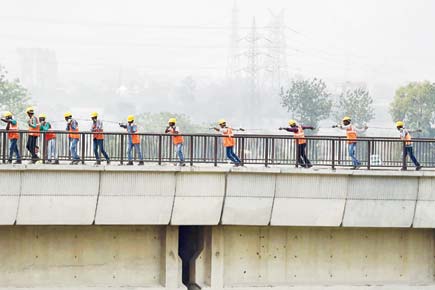Every ‘debate’ on TV is choking the life out of air pollution, but they only focus on the aftermath of Diwali or the burning of crop stubble


As per the latest health advisory, all construction and demolition activities at Delhi Metro sites and areas under the jurisdiction of municipal corporations have been suspended for this week with immediate effect to improve the air quality. Pic/AFP
The weather app on my phone has been persistent with its forecast of ‘light fog’ or ‘haze’ every morning since the monsoon ended. It would an understatement to say this is a bad time for North India. Every dirt and dust particle in the Universe, apparently, comes and settles in this part of the world and everything you do only adds to the thick layers of suspended particulate matter and all other particles and matters.
ADVERTISEMENT
Yes, the time of the year makes it worse — no winds, nothing to disperse the particles, Diwali celebrations and farmers burning leftover crops in their fields to prepare for the next planting season.
However, there is much more to it than that. Every single report on air pollution factors has three problems which overshadow the rest, but they are factors which we would prefer to ignore. The first is vehicular pollution, the second is construction dust and the third is industrial pollution.
Many assumed that when I moved from Mumbai to Dehradun over two years ago, my biggest enjoyment in life would be fresh air. For a couple of innocent months it did seem like that to a city dweller. Damn, the air was so clear and so full of pollen and lack of pollution that I had to take antihistamines to process it all!
Now, there’s construction pollution — both air and sound, everywhere — so I almost feel like I’m in Mumbai again! Yes, I see hills from the windows. Potentially, I could also see snow, but for two years the winter rains have been missing in action leading to acute water shortages and, well, no snow-covered hills. I can also see trees and vegetation being replaced by apartment blocks.
Ultimately, whichever way you look at it, as you destroy the environment, you will lose everything you once thought precious and that includes clean, breathable air. Ironically, New Delhi has plenty of trees and it has The Ridge. But those are no longer enough. Delhi also has more cars than other Indian cities and if the city government tries to do anything about that, it feels the wrath of a populace which thrives on the power in its wheels. Gurugram, which is almost part of Delhi, has no Ridge, no trees and no Aravallis any more, so hands down it is worse off than the national capital.
Here in the villages above Dehradun’s congested, clogged city centre — known so evocatively as Ghantaghar, though I have never heard the clock chiming, let alone telling the time — cement dust makes the air seem like any other big city. A few years ago, there were some rules about construction-work on the hills, but, perhaps, those are customs more honoured in the breach. Interestingly, many of the flats in these virus-like apartment blocks are unsold and yet, they keep building them year after year.
You can see the disaster that will come sooner or later — anyone can. This is a heavy seismic zone and the area is renowned for its greenery and scenery. But so what? Name your building ‘Whispering Willows’ and some city sucker might imagine that makes up for an actual willow tree.
I know the arguments. Progress. Human development. But, I also know the other arguments. Sustainability. Catastrophe. And I would happily err towards the second ones. Because even with farmers burning crops and people overdoing it on Diwali, if we had paid attention to the environmental damage wreaked by unchecked construction posing as ‘development”, there might yet have been some clean air to breathe.
I feel like I’ve said all this before. I know many people have said all this and a lot more more and in a better way, before me. But what difference has it made? Every ‘debate’ on television news on this subject has been about Diwali and farmers and political one-upmanship. Every point made has been about the immediate issue and not about the future. We have heard that a staggering 20,000 people may die this year in Delhi alone from pollution-related causes.
Ghastly as that is — and it is — consider this: by 2020, we are going to lose 67 per cent of all wild animals if we don’t do something now, according to a new study. Poaching, human activity and pollution will be to blame. Now, take a deep breath. Or, actually, don’t.
Ranjona Banerji is a senior journalist. You can follow her on Twitter @ranjona. Send your feedback to mailbag@mid-day.com
 Subscribe today by clicking the link and stay updated with the latest news!" Click here!
Subscribe today by clicking the link and stay updated with the latest news!" Click here!







